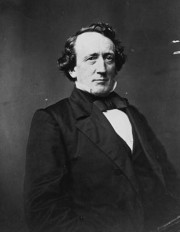Transportation

Red River and Indian Trails
Dakota and Ojibwe people developed an extensive network of routes in what is now Minnesota for trade and other purposes. Among the most important of these routes were the Mississippi, Minnesota, Missouri and other rivers. These routes (with the Great Lakes) connected Ojibwe and Dakota people with other American Indians over a vast area. At Yankton, Prairie du Chien and other sites along these rivers, American Indian nations met annually for trade fairs that moved goods throughout the upper Midwest and beyond.
As traders of European descent entered the economic life of the Dakota and Ojibwe people, these trails were used to deliver trade goods and transport furs. In several of the treaties that the US signed with Ojibwe and Dakota people, treaty articles called for construction of roads – usually along the routes that American Indians had always used – for the easier movement of more trade goods. (These roads also made U.S. military movement easier; by the 1860’s, Alexander Ramsey was arriving at treaty sites with hundreds of troops.)
Over time, transportation itself became the basis for individual and corporate fortunes. The first Ojibwe and Dakota land cessions in 1837 used the Mississippi as a boundary, opening navigation rights to American companies. In the next 20 years, steamboat companies were formed to carry goods along the rivers, turning traditional American Indian meeting places into economic hubs for the U.S.
Beginning in 1854, the federal government granted land, recently ceded by Dakota and Ojibwe people, to railroad companies in Minnesota. The Territorial government had the authority to distribute this “free” land, and over the next 3 years 25 railroad companies were formed in the Territory, most of which were co-owned by Territorial legislators. Although the vast majority of these ventures were speculative – shares in the companies were sold, but no rail was laid – rail lines began to connect sites on the Mississippi, the Red River and Lake Superior, generally following the trails established by Dakota and Ojibwe people. (Today, Interstates 35 and 94 in Minnesota follow the same routes.) Railroads were given millions of acres by the government; selling this land to settlers raised money to build the rails, run the companies, and make their owners wealthy. As towns grew along the rail lines, and the ability to move timber and other resources grew, pressure from settlers and businesses to remove Dakota and Ojibwe people from their land also grew.
Before railroads reached the Red River, Norman Kittson operated a highly-profitable business using oxcarts along the river. Eventually, his company also entered the railroad business, becoming one of the foundations of the Great Northern Railway. Kittson’s brother John signed a treaty with the Menominee, and his brother-in-law Alan Morrison signed the Ojibwe land cession treaties of 1847.
Transportation companies had a great interest in the transfer of land and resources from Dakota and Ojibwe people to the US. Consequently, they were represented at many of the Dakota and Ojibwe treaties with the U.S.
US signers of treaties with the Dakota and Ojibwe who had significant interests in transportation companies include:
- Samuel Abbe (who signed the Red Lake Ojibwe treaty, 1863) was a director of the Lake Superior and Crow Wing Railroad; the Mississippi and Lake Superior Ship Canal Company.
- Alexis Bailly (who signed the Dakota 1851 treaties) was a director of the Red River of the North Railroad.
- Joseph R. Brown (who signed the Dakota 1858 treaties) was a director of the Minnesota, Nebraska and Pacific Mail Transportation Company; Minnesota and Pacific Railroad; Mississippi River and Lake Superior Ship Canal Company; Nebraska and Lake Superior Railroad; and Minnesota and Dakota Railroad.
- N. R. Brown (a brother of Joseph and also a signer of theDakota 1858 treaties) was a director of the Minnesota and Dakota Railroad.
- Reuben Carlton (signer of an 1847 Ojibwe treaty) was a director of the Minnesota Point Ship Canal Company; and the Nebraska and Lake Superior Railroad. (See mining.)
- Richard Chute ( who signed an 1846 Ho-Chunk treaty and the 1851 Dakota Mdewakanton/Wapekute treaty) invested in the construction of 52 steamboats, and was a director of the Minnesota and Pacific Railroad. (See timber and fur trade.)
- Hercules Dousman was a co-owner of the Galena and Minnesota Packet Company, a steamboat company formed in 1854.
- Alexander Faribault was a director of the Red River of the North Railroad.
- E. A. C. Hatch (who signed an 1863 Ojibwe treaty) was a director of the Minnesota, Nebraska and Pacific Mail Transportation Company; and the Mississippi River and Lake Superior Ship Canal Company, (See mining.)
- Joseph W Lynde (who signed an 1847 Ojibwe treaty) was a director of the Mississippi River and Lake Superior Ship Canal Company; the Minnesota, Nebraska and Pacific Mail Transportation Company; and the Lake Superior and Crow Wing Railroad. (See land speculation and mining.)
- Charles Oakes was a director of the Minnesota and Pacific Railroad Company.
- Alexander Ramsey was on the board of directors for Minnesota Central Railroad; the Minnesota and Pacific Railroad; the Saint Peter Western Railroad; the Lake Superior and Crow Wing Railroad; the Nebraska and Lake Superior Railroad; the Nininger, St. Peter, Western Railroad; the Saint Paul and Taylor's Falls Railroad; the Minnesota and Dakota Railroad; and the Red River of the North Railroad.
- Henry Mower Rice was a co-owner of the Galena and Minnesota Packet Company; and a director of the Red River of the North Railroad.
- Henry Sibley was a co-owner of the Galena and Minnesota Packet Company.
- Indian agent Clark W. Thompson was in charge of production for the Southern Minnesota Railroad.
- Charles Trowbridge was president of the Oakland and Ottawa Railroad Company and a director of the Detroit and St. Joseph Railroad.














